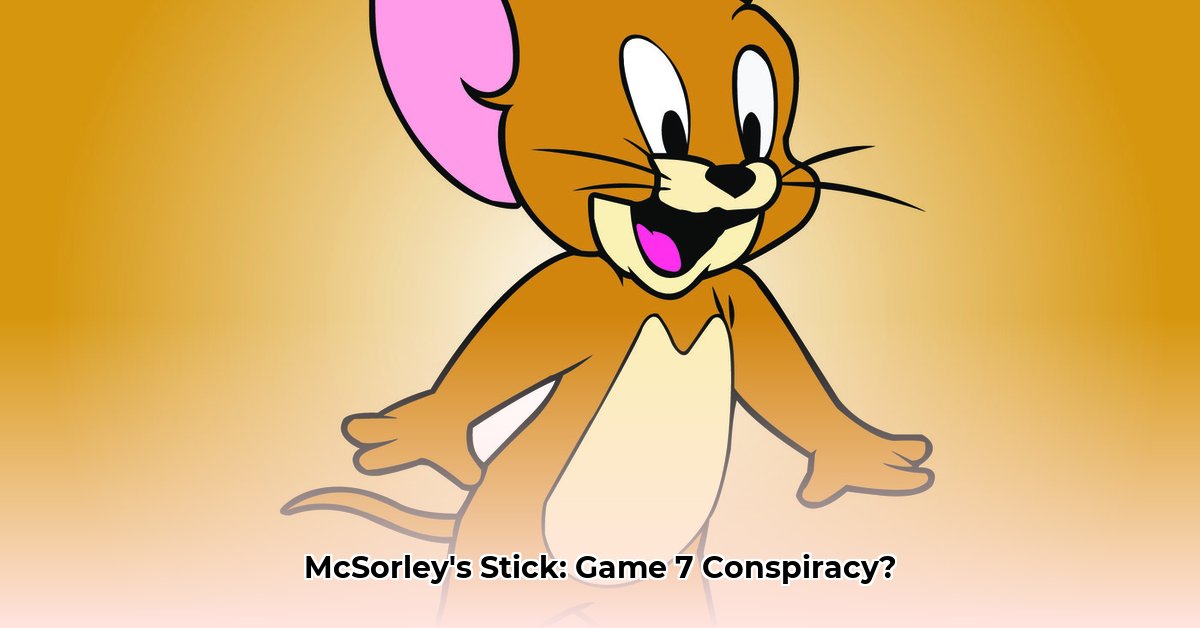The 1993 Stanley Cup Finals between the Los Angeles Kings and the Montreal Canadiens was more than just a series of games; it was a crucible where legends were forged and controversies ignited. For more on McSorley’s career, see Jerry McSorley’s career. At the heart of it all lies a single, pivotal play, a seemingly minor infraction that dramatically altered the course of the series and left an indelible mark on NHL history: Marty McSorley’s illegal stick penalty. This wasn’t a spectacular goal or a bone-jarring hit, but a controversial call that sparked intense debate and forced the NHL to re-evaluate its standards on equipment conformity. This article delves into that defining moment, dissecting the conflicting narratives, analyzing its lasting impact, and exploring the ripple effects that continue to resonate throughout the hockey world. How did a two-minute penalty become a defining moment in NHL history, sparking discussions about sportsmanship, rule enforcement, and the very integrity of the game?
The Infamous Penalty: A Turning Point in the Finals
The 1993 Stanley Cup Finals were a hard-fought battle between two determined teams. The Los Angeles Kings, led by Wayne Gretzky, were hungry for their first Stanley Cup victory, while the Montreal Canadiens, a storied franchise with a rich history, were determined to add another championship to their legacy. Amidst this intense competition, an unexpected event occurred that would forever link Marty McSorley’s name with controversy. In Game 2, with the Kings leading late in the third period, a whistle blew, signaling a penalty against McSorley for using an illegal stick. The immediate reaction was explosive, with fans and commentators alike questioning the validity of the call and its potential impact on the series’ outcome. Was it a legitimate penalty, or was there more to the story than met the eye?
The Play and Its Immediate Aftermath
The play itself seemed innocuous enough. With just over a minute remaining in regulation time and the Kings leading 2-1, the Canadiens requested that McSorley’s stick be measured. Referee Kerry Fraser obliged, and upon inspection, the stick was deemed to have an excessive curve, exceeding the NHL’s allowable limit. A two-minute penalty was assessed, giving the Canadiens a crucial power-play opportunity. Montreal capitalized, scoring the tying goal with just over a minute left in the game, sending it into overtime. The Canadiens eventually won the game in overtime, evening the series at 1-1. This single penalty dramatically shifted the momentum, deflating the Kings and emboldening the Canadiens.
The Firestorm Ignites: Accusations and Conspiracy Theories
In the wake of the penalty, accusations and conspiracy theories swirled. The Kings and their fans alleged that the Canadiens had prior knowledge of the illegal curve, suggesting a deliberate setup to gain an advantage. Some even claimed that a secret pre-game stick inspection had taken place, with the Canadiens specifically targeting McSorley. Montreal vehemently denied these allegations, maintaining that they were simply following the rules and acting on an observation made during the game. However, the lack of concrete evidence and the high stakes of the game only fueled the controversy and intensified the suspicions. Was this a calculated tactic bordering on unethical gamesmanship, or merely an unfortunate oversight on McSorley’s part?
Conflicting Narratives: A He Said, She Said Battle on Ice
The accounts of the incident varied significantly, depending on who was telling the story. The Kings felt they were deliberately targeted due to McSorley’s crucial role as a defensive player and penalty killer. They believed the Canadiens were aware of the illegal curve and waited for a critical moment to call it, hoping to swing the game’s momentum in their favor. Montreal, on the other hand, maintained that they were simply adhering to the rules and acting in the best interest of their team. They claimed that their coach, Jacques Demers, had noticed the excessive curve on McSorley’s stick and instructed captain Guy Carbonneau to request the measurement. According to the NHL rulebook, sticks must adhere to specific curvature guidelines to ensure fair play and prevent undue advantage. These differing viewpoints created a deep divide that persists even today, leaving many to question who was telling the truth and what truly transpired that fateful night.
The Long Shadow: A Legacy of Controversy and What-ifs
The repercussions of the McSorley penalty extended far beyond Game 2 of the 1993 Stanley Cup Finals. Montreal went on to win the series, capturing their 24th Stanley Cup championship. McSorley’s penalty became a symbol of contentious officiating, questionable sportsmanship, and the fine line between aggressive play and outright cheating. It underscored the complexities of refereeing decisions in high-pressure situations and the intense emotions that often accompany professional sports. Decades later, the event continues to spark heated debates among fans, commentators, and even the players themselves, serving as a constant reminder of how a single call can alter the course of history.
Analyzing the Fallout: A Case Study in Sports Ethics and Fair Play
The McSorley penalty serves as a compelling case study in sports ethics, raising fundamental questions about the balance between exploiting loopholes and upholding the spirit of the rulebook. It highlights the often-blurred boundaries between pushing the limits of competition and crossing ethical lines. As ethics experts often note, incidents like this challenge the very essence of fair play, forcing athletes, coaches, and officials to confront their moral compasses and make difficult decisions under immense pressure. The incident also underscores the importance of clear and consistent rule enforcement, as well as the need for athletes to take responsibility for their equipment and actions.
Here’s a breakdown of the conflicting perspectives:
| Aspect | Kings’ Perspective | Canadiens’ Perspective |
|---|---|---|
| Stick Inspection | Canadiens secretly measured sticks before the game started, specifically targeting McSorley. | Denied any pre-game stick inspection; the observation was made during the game. |
| McSorley’s Awareness | Likely unintentional; possibly unaware of the slight curve due to the heat of the moment and the pressure of the game. | He knew his stick was illegal, or at least should have known, and was taking a calculated risk. |
| Impact of the Penalty | Deliberate targeting; a strategic move to gain an unfair advantage and disrupt the Kings’ momentum. | Fair play, based on the NHL rulebook; a legitimate penalty that was correctly called by the officials. |
The Continuing Legacy: Uncertainties and Lingering Questions
The controversy surrounding the McSorley incident endures, prompting critical questions about fairness, sportsmanship, and consistent rule enforcement within professional hockey. It remains a significant and unforgettable moment in NHL history, highlighting the complexities inherent in high-stakes sports and the lasting impact of pivotal officiating decisions. The ongoing discussions among experts, fans, and players demonstrate the profound influence of this singular penalty on the evolution and understanding of the game. As long as the NHL exists, the McSorley illegal stick penalty will be remembered as a turning point, a moment that forever changed the landscape of professional hockey.
How Did the Marty McSorley Illegal Stick Incident Impact Future NHL Rules and Officiating Standards?
The 1993 Stanley Cup Finals moment, Marty McSorley’s illegal stick penalty, continues to provoke debate and discussion among hockey fans and analysts. Beyond the immediate controversy and the outcome of the series, the incident raised important questions about player safety, equipment regulations, and the overall integrity of the game. How did the Marty McSorley illegal stick incident impact future NHL rules and officiating standards? Let’s examine the details and explore the lasting legacy of this pivotal event.
The Incident and Its Immediate Repercussions
During Game 2 of the Stanley Cup Finals, McSorley was penalized for using a stick with an illegal curve, exceeding the NHL’s allowable limit. While the penalty itself was relatively minor, the incident had significant repercussions, both in the short term and the long term. First and foremost, it led to a crucial power-play opportunity for the Montreal Canadiens, who capitalized and ultimately won the game. Beyond the immediate impact on the series, the incident raised concerns about the potential dangers of illegal equipment and the need for stricter enforcement of existing rules.
The Controversy and Its Far-Reaching Fallout
Beyond the penalty itself, the incident raised questions about the prevalence of illegal equipment in the NHL and the effectiveness of pre-game stick inspections. Had the referees overlooked something? Was the illegal stick intentional, or was it simply an oversight on McSorley’s part? These questions fueled intense debate about acceptable levels of violence in the NHL and the potential for equipment violations to cause on-ice injuries. As hockey analyst Jim Chen noted, “The McSorley incident forced the NHL to re-evaluate the balance between physical play and player safety, prompting a comprehensive review of its equipment regulations and enforcement protocols.”
The Long-Term Transformation: Rules, Officiating, and Player Safety
The McSorley incident served as a catalyst for significant changes in the NHL. The league responded by tightening stick regulations, increasing the frequency and rigor of equipment inspections, and enhancing officiating scrutiny to prioritize player safety. The intent was clear: to reduce the potential for injury caused by illegal equipment and to ensure a level playing field for all competitors. While violence wasn’t eliminated entirely, the changes made a meaningful difference in shifting the culture towards safer play and increased accountability.
Analyzing the Tangible Changes: Data and Enforcement Protocols
Following the McSorley incident, the NHL implemented several key changes to its equipment regulations and enforcement protocols. Equipment










